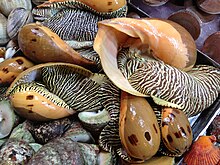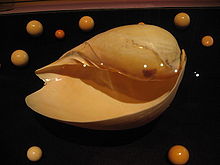Melon snail
| Melon snail | ||||||||||||
|---|---|---|---|---|---|---|---|---|---|---|---|---|

Melo melo in the sink |
||||||||||||
| Systematics | ||||||||||||
|
||||||||||||
| Scientific name | ||||||||||||
| Melo melo | ||||||||||||
| ( Lightfoot , 1786) |
The melon snail or zebra snail ( Melo melo ) is a large snail from the family of roller snails (genus Melo ), which is common in the central Indo-Pacific . It feeds on snails .
features
The large, round, egg-shaped shell of Melo melo reaches a length of around 18 cm in adult snails, sometimes up to 28 cm. The thread is completely enveloped by the rear end of the very large, inflated body perimeter. The surface on which you can only see the growth lines is smooth. The body is rounded at the top, without edges and without spikes. The wide open case mouth takes up the entire length of the case and has a rather thin, curved edge. The columella has 3 or 4 long and protruding oblique folds. A wide open notch is formed in place of a siphon channel. An operculum is missing.
The outer surface of the house is pale orange and sometimes covered with irregular bands of dark brown spots. The shiny interior of the case is cream colored with a light yellowish edge.
The snail itself is drawn in black and white in a zebra-like pattern. She has a broad foot and a long siphon .
The snail sometimes forms pearls , but without mother-of-pearl .
distribution
The melon snail lives in the central Indo-Pacific and South China Seas in the waters of Burma , Thailand , Malaysia , Indonesia , Cambodia , Vietnam , China and the Philippines .
Habitat and way of life
The melon snail lives in the intertidal zone and below to a depth of 20 m, mainly on muddy subsoil.
Life cycle
Like other new snails, Melo melo is segregated. The male mates with the female with his penis . The female lays balls of several round egg capsules, each containing an egg. The development of the finished snail takes place completely in the egg capsule, so that finished snails hatch after a few months. When hatching, the juvenile snails have about 3 cm long shells, which makes them one of the largest hatchlings among snails.
nutrition
Melo melo mainly eats snails . Laboratory tests suggest that it prefers predatory species of snails as prey, including Hemifusus tuba ( Melongenidae family ) and Babylonia lutosa ( Buccinidae family ). In other experiments, Pugilina cochlidium (Melongenidae) and Murex trapa ( Muricidae ) were eaten, while Lunella cinerea ( Turbinidae ) and Perna viridis ( Mytilidae ) were not touched. The melon snail is also an important predator of large herbivorous snails, such as the canine wing snail ( Laevistrombus canarium ). The prey is grasped with the predator's large foot and suffocated. Choline esters play a role in numbing the victim. The proboscis of the snail can now be guided to the meat, which is rasped with the radula . Finally, the empty shell is discarded.
Human use and exposure

Melo melo is collected for its case, which is sold as jewelry. In addition, the meat is eaten. The bowl is also used to measure salt, sugar and flour and to scoop water from boats.
Web links
- Volutidae: Melo melo (Lightfoot, 1786) . From: JM Poutiers: Gastropods . In: Kent E. Carpenter, Volker H. Niem (Eds.): FAO Species identification guide for fishery purposes. The living marine resources of the Western Central Pacific. Volume 1: Seaweeds, corals, bivalves and gastropods. Food and Agriculture Organization of the United Nations, Rome, 1998. p. 598.
- Fischhaus Zepkow: Family Volutidae - roller snails
Individual evidence
- ↑ M. Amio (1963): A comparative embryology of marine gastropods, with ecological considerations . Journal of the Shimonoseki College of Fisheries 12, pp. 229-353.
- ^ Brian Morton (1986): The diet and prey capture mechanism of Melo melo (Prosobranchia: Volutidae) . Journal of Molluscan Studies 52 (2), pp. 156-160.
- ↑ a b Aileen Tan Shau-Hwai, Shirley Lim Mei Hui, Zulfigar Yasin (2011): The Feeding Behavior of Volutidae snail, Melo melo (Lightfoot, 1786) (PDF file; 232 kB) . Proceedings of the 7th IMT-GT UNINET and The 3rd International PSU-UNS Conferences on Bioscience, pp. 140-142.
- Jump up ↑ ZC Cob, A. Arshad, JS Bujang, MA Ghaffar (2009): Age, Growth, Mortality and Population Structure of Strombus canarium (Gastropoda: Strombidae): Variations in Male and Female Sub-Populations . Journal of Applied Sciences 9 (18), pp. 3287-3297.

